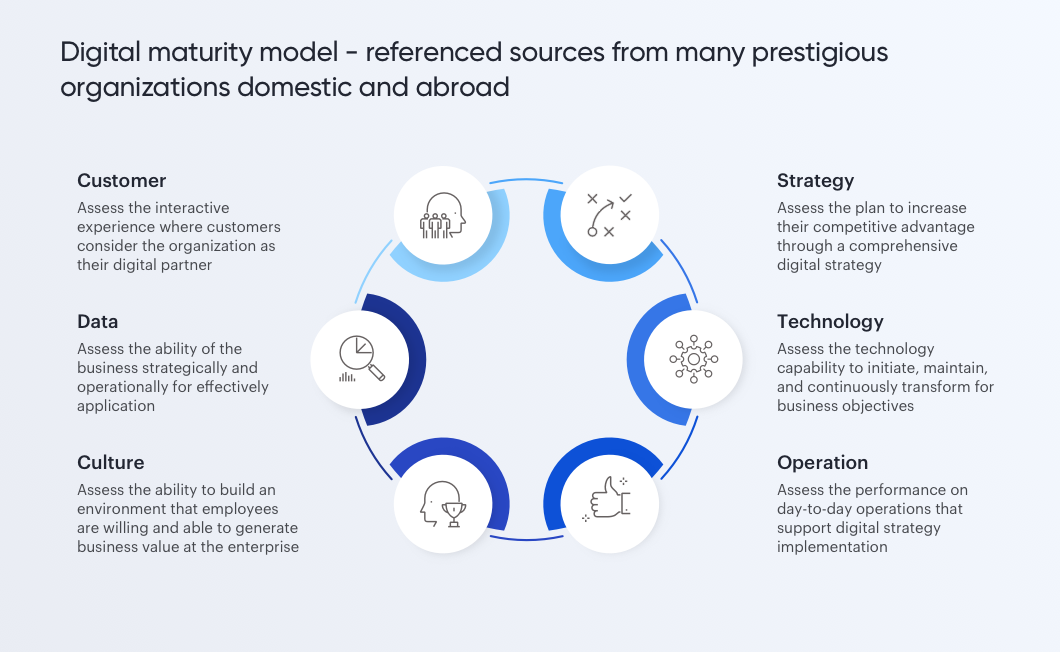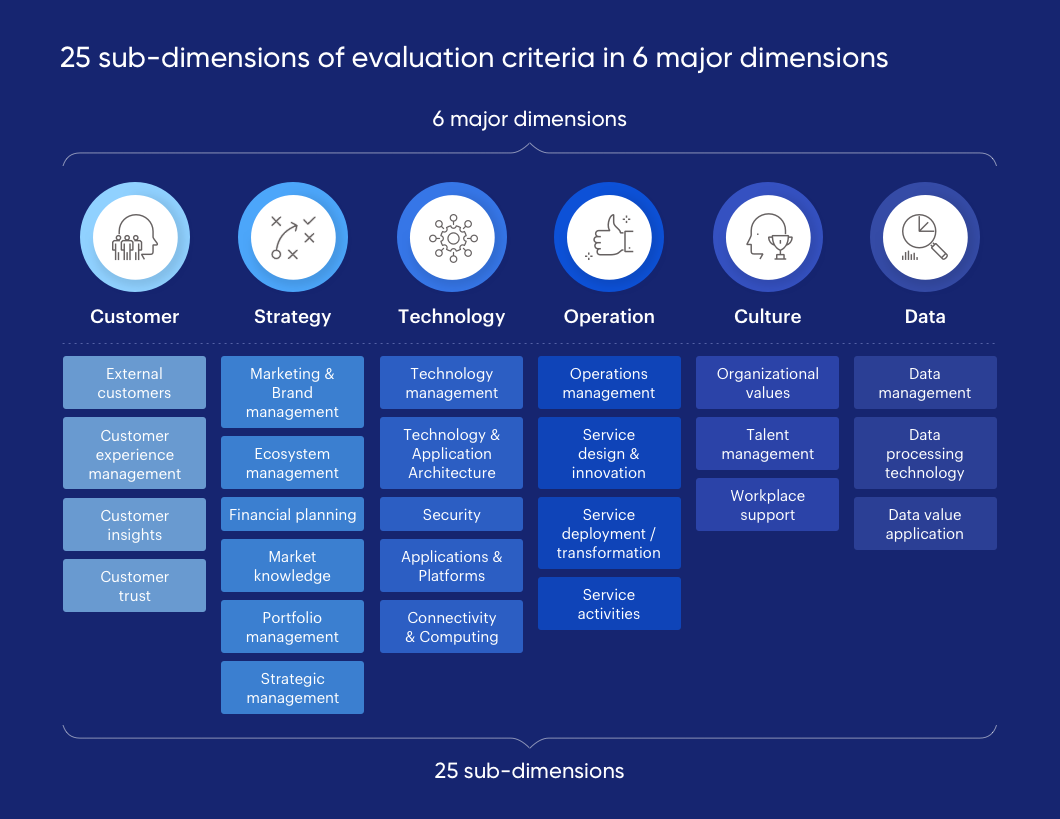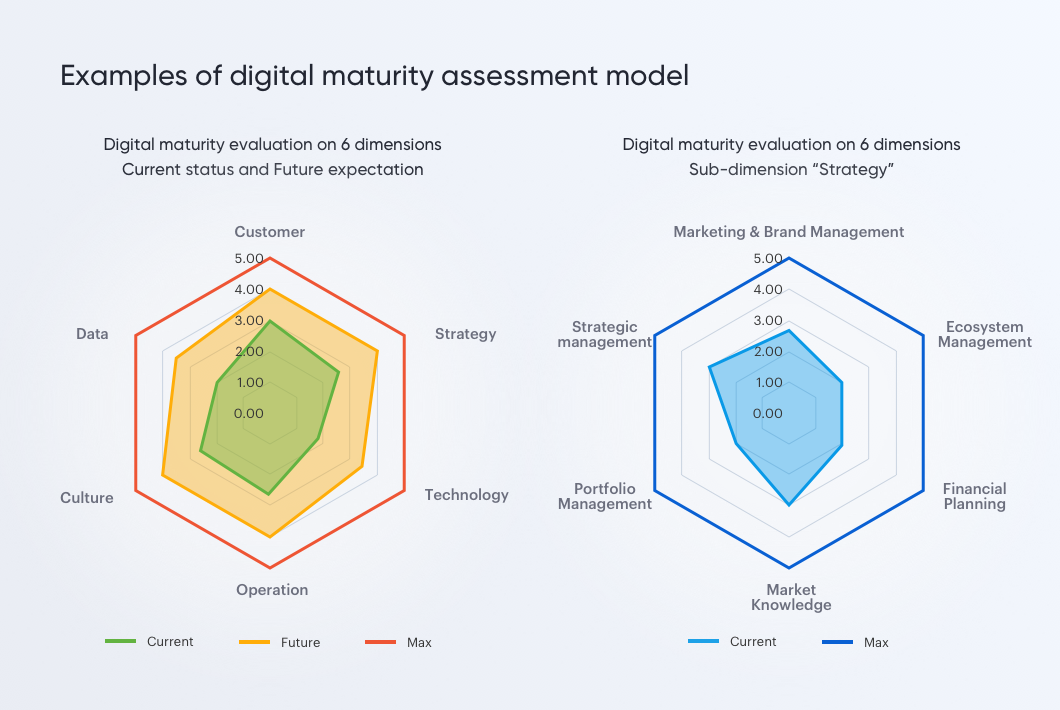The application of digital transformation technology has become businesses’ strategy to develop and build competitive advantages in the era of Industry 4.0. However, planning a digital transformation roadmap has depended on many factors. In order to navigate the transformation journey optimally, considering practical and specific characteristics, positioning and evaluating the current state of digital maturity is essential for businesses.
Positioning current digital maturity state to navigate business’ digital transformation journey
Recently, the phrase “digital transformation” has been frequently mentioned. “Digital transformation” is seen as inevitable, especially during the continuous complex pandemic situation that makes it difficult for traditional business models to operate normally. The term is defined from different points of views, but in Vietnam, digital transformation has been mostly construed as the process of transforming the old and traditional model to the digital model, based on new technology applications such as big data, IoT, cloud computing,… in order to improve operational methods, workflow, and corporate culture.
The transition from a traditional model to a comprehensive digital model requires a roadmap transformation. There is no common roadmap that can be applied to all businesses; it must be built and customized on the characteristics of each industry, each business.
Digital transformation is not the destination but the transition from the current state to the desired future state, leveraging the potential of technology as a transforming engine. Based on business vision and strategy, businesses will identify digital strategy to be achieved and critical tasks to be solved. However, many businesses are unable to succeed to digital transform, largely due to misidentification of the current state – the initial starting point, which are:
- Businesses have not yet properly assessed the importance of digital transformation. Many consider digital transformation as a support tool, and not as the core for making the difference, transforming the business from the current state to the desired future state.
- Business have not yet thoroughly and well assessed “Where the business is” in the digital transformation roadmap leads to faults when defining strategy.
In order to build a digital transformation roadmap with phases effectively while meeting business objectives, business needs to identify accurately the importance of digital transformation and understand its current level of digital maturity.
The Digital Maturity Model (DMM) is a model that helps businesses assess the current level in terms of digital maturity and digital transformation readiness, which perform as the foundation for businesses to navigate the digital transformation journey.
The digital maturity model
A digital maturity model, based on reference sources from many prestigious organizations domestic and abroad comprehensively, measures the overall level of digital maturity on 6 key aspects of the enterprise’s operation and business activities including Customer, Operation, Strategy, Technology, Culture, and Data.

At FPT Digital, the model is adapted to be suitable for Vietnamese enterprises. Details in the 6 major dimensions are 25 sub-dimensions with a total of 139 evaluation criteria, in order to assess the overall aspects of the business accurately.

For major dimension Customer, 4 sub-dimensions are as follows:
- External customers: The organization delivers excellent experiences with its products and services
- Customer experience management: An internal organization and administration system is set up to deliver customer experiences
- Customer insights: Organizations use data efficiently to gain customer insights
- Customer trust: The experiences provided is in line with the promise from the business brand
For major dimension Strategy, the 6 sub-dimensions are as follows:
- Marketing & Brand management: Consistent brand communication is developed and maintained across all channels
- Ecosystem management: Businesses leverage ecosystem to create business values
- Financial planning: Financial sponsorship applied to support digital transformation strategy
- Market knowledge: Market information collected to inform strategies
- Portfolio management: Businesses maintain a balanced portfolio of digital products and services
- Strategic management: The business develops and adopts a coherent and complete digital transformation strategy
For major dimension Technology, 5 sub-dimensions are as follows:
- Technology management: Business well manages the use of technology in research, development and production of goods and services
- Technology & Application Architecture: Business has a technology and application architecture that describes the behavior of applications and has integration with technology and service platforms
- Security: Businesses plan and proactively address threats, security vulnerabilities, and security compliance requirements
- Applications & Platforms: Technology platforms and tools are launched to develop and effectively manage applications and processes
- Connectivity & Computing: The business has the connectivity and computation capabilities needed to support digital business operations
For major dimension Operation, 4 sub-dimensions are as follows:
- Operational management: Business effectively manage its operation
- Service design & innovation: Business can effectively design and develop innovative services that bring business values
- Service deployment / transformation: Business can quickly, flexibly and efficiently provide and deploy and stop services
- Service operations: Business operates services in production and activities, ensuring the readiness, quality and ability to meet changing needs
For major dimension Culture, 3 sub-dimensions are as follows:
- Organizational values: Organizational values are set to drive the employee experiences
- Talent management: Business has the capabilities, knowledges and tools to create and develop an effective workforce
- Support from the workplace: Work environment, tools and experience of the organization that supports productivity and innovation
For major dimension Data, 3 sub-dimensions are as follows:
- Data management: Business has an effective data management system
- Data processing techniques: Business has efficient systems and processes for data collection, transfer, storage and processing
- Data value realization: Business can recognize business values from data assets
The 139 more detailed criteria in the model were evaluated on a scale of 1 to 5 corresponding to the level of maturity; the higher score, the higher the digital maturity. Based on the score of the detailed criteria that the level of digital maturity in each sub-dimension as well as the large dimension will be assessed. Through this model, FPT Digital also shared a regard on the “Digital transformation trap” which will occur if a business does not properly evaluate and understand the level of its digital maturity, leading to limitations in the process of planning and implementing the digital transformation roadmap.

In order to assess the exact details of each criterion, FPT Digital will conduct a process to survey the entire business from the Board of Directors to the departments to collect information about the current state from various insights. The final assessment results give the business an overall and detailed view of digital maturity. Based on this model, business can also identify dimensions that should be focused for development and enhancement.
Continue the digital transformation journey with building a digital transformation roadmap
Based on the identified level of digital maturity and the business strategies by phases, business can develop a digital transformation roadmap that fits its current status quo. However, it should also be noted that the development of the appropriate digital transformation roadmap must also consider other possible factors.
In the national context of accelerating digital transformation, Vietnamese enterprises further step up the implementation of digital transformation. Assessing the level of digital maturity will help businesses to perform right from the first steps on transformation journey, to optimize digital transformation activities in the later stages. During the assessment process, another objective perspective from the outside (e.g., a consulting partner) that separates from the internal perspective of the business, will provide the most intuitive and accurate view points to help ensure the success of the digital transformation as well as to achieve the desired goals in the future.





